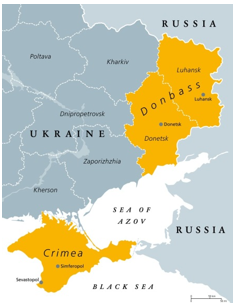

22nd February 2022 (6 Topics)
Context
President Vladimir Putin recently told his Security Council that Russia should consider recognising the independence of the self-proclaimed Donetsk People’s Republic and the Lugansk People’s Republic in Donbass as independent.
About
About Donbass region:
- Location:
- The Donetsk and Luhansk regions collectively known as the Donbas are in eastern Ukraine, near the border with Russia.
- The region comprises both Kyiv-controlled parts as well as separatist-controlled areas.
- Its main industries are coal mining and steel production.
- The geographical location of the Donbas facilitated industrial growth:
- it lies only 120–150 km from the Sea of Azov,
- 350–450 km from the Kryvyi Rih Iron-ore Basin,
- 300–350 km from the Kerch Iron-ore Basin,
- 300–350 km from the Nikopol Manganese Basin,
- Close to the largest consumers of its coal—the metallurgical, energy, and other industrial centers.
- Population:
- Most of the 3.6 million people living in the Donetsk and Luhansk regions speak Russian, a result of a migration of Russian workers to the regions after World War II, during the Soviet era.
About the crisis:
- The Donbass region, comprising the Donetsk and Luhansk oblasts of Ukraine, has been at the centre of the conflict since March 2014 when Moscow invaded and annexed the Crimean Peninsula.
- In April 2014, pro-Russia rebels began seizing territory (with Russia supporting them through hybrid warfare) in Eastern Ukraine and in May 2014, the rebels in the Donetsk and Luhansk regions held a referendum to declare independence from Ukraine.
- Since then, these predominantly Russian speaking regions (more than 70% speak Russian) within Ukraine have been witnessing shelling and skirmishes between the rebels and Ukrainian forces.
About Minsk agreements:
- There are two Minsk agreements, Minsk 1 and Minsk 2.
- Minsk 1 was written in September 2014 by the Trilateral Contact Group on Ukraine, i.e. Ukraine, Russia, and the OSCE with mediation by France and Germany.
- Under Minsk 1, Ukraine and the Russia-backed rebels agreed on a 12-point ceasefire deal, which due to violations by both sides, did not last long.
- In February 2015, representatives of Russia, Ukraine, the OSCE and the leaders of Donetsk and Luhansk signed a 13-point agreement, now known as the Minsk 2 accord.
- However, the provisions under the agreement have not been implemented because of the ‘Minsk Conundrum’.
- Russia believes that the agreement asks Ukraine to grant the Russia-backed rebels in Donbas comprehensive autonomy and representation in the central Government.
- Only when this is done will Russia hand over control of the Russia-Ukraine border to Ukraine.
- Ukraine, on the other hand, feels that Minsk 2 allows it to first re-establish control over Donbas, then give it control of the Russia-Ukraine border, then have elections in the Donbas, and a limited devolution of power to the rebels.
- Ukraine believes the accord supports its sovereignty fully while Russia believes it only gives Ukraine limited sovereignty.
- Thus, the Minsk 2 agreement has been rightly criticised for being too hastily drafted, ambiguous and contradictory, making it difficult to implement.




